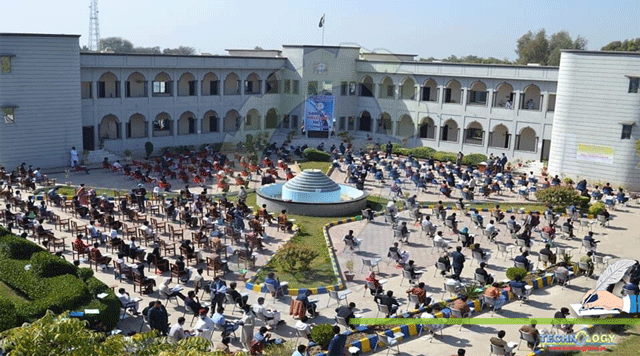Pakistan is an agricultural country and livestock contributes to lions’ portion with a share of 58.92 per cent in agriculture and 11.11 per cent in GDP. Livestock also contributes in a variety of ways to the national economy, as it contributes 40 per cent of the global value of agricultural output and supports the livelihoods and food security of almost a billion people.

By Dr Syed Farooque Hassan Mati
In Pakistan, more than 70 per cent masses earn a livelihood by rearing livestock which is now one of the fastest-growing businesses in the agricultural economy, driven by income growth and supported by technological and structural change.
However, this sector has many areas that need to be investigated aimed at improving production potential through better husbandry, mass awareness and best-breeding programs not at the cost of compromising at the conservation of indigenous germplasm and gene pool of local breeds.
Applications of livestock including poultry and fisheries may not be ignored as animals are a source of food (meat & dairy products.). Animals fulfil the protein needs for human diets, help in income generation, manpower employment, and conceivably earning foreign capital. For low-income producers, livestock can serve as a store of wealth, provide draught power and organic fertilizer for better crop production and a means of transport. However, growth in agricultural production and productivity is needed to raise rural incomes, to support the increasing numbers dependent on the industry and to meet the food and raw material needs of the faster growing urban populations. Enhancing agricultural productivity contributes to industrial growth by providing cheap labour, capital investment, foreign exchange, and markets for manufactured consumer goods.
Livestock provides over half of the value of global agricultural output and one third in developing countries. Rapid growth in demand for livestock products (LPs), in developing countries, is viewed as a ‘food revolution’. LPs are costly concerning staple foods, so developing country consumption levels are still low, but increase with rising incomes. Pig and particularly poultry meat consumption is growing fastest. Consumption growth is at the expense of increasing net imports of all LPs. Increased production and higher self-sufficiency would save foreign exchange. Livestock also contributes to rural livelihoods, employment, and poverty relief. They integrate with and complement crop production, embody savings, and provide a reserve against risks. Some livestock has special roles in traditional culture (http://www.fao.org/ag/pplpi.html).
When compared with other agricultural economies, the production potential of Pakistan is lurking in the lake. Therefore, there is a dire need to address the issues and exercise the options for a sustainable outcome. Inter-regional differences in livestock production systems depend upon agro-ecological features, human population density and cultural norms. A comparison of the main developing country continents shows that Sub-Saharan Africa, Latin America and the Near East, with reasonably large areas of land per person engaged in agriculture, have a greater proportion dependent on grassland-based, ruminant livestock systems than do the more densely populated, land-scarce, regions of South and East Asia. Nonetheless, in all the continents listed, most of the agricultural population are engaged in mixed farming systems. These are mainly rain-fed in Africa and Latin America but, in South and Eastern Asia and the Near East, about half are irrigated. Poultry production is a key enterprise in Latin America, particularly Brazil, and in East and Southeast Asia, mainly China which is also a major pig producing country. South Asia is the largest milk-producing region (http://www.fao.org/ag/pplpi.html).
Veterinary education in this regard may play a pivotal role, hence long-term planning is required by investing in veterinary education, which in past has remained by and large an ignored area. Veterinarians are pursuing diverse careers, indeed, with our encouragement and support. aquaculture, ranched wildlife, food safety, industrial research, biotechnology, and a plethora of clinical specialties are all career opportunities that are available for veterinarians. We are advocating these choices actively within our student body and extending this encouragement to our graduates who may be considering career changes (Shadduck, 1994)
Veterinary institutes struggle to prepare graduates for a variety of career options with the skills and knowledge to use and contribute to research as part of their lifelong practice of evidence-based veterinary medicine. That seems a mature and long-term approach and for that, there is a need to develop policies such as skill-based curriculum, particularly in clinical subjects, and students should receive lab skills as well as can consider skill-based careers (DOI: 10.3138/jvme.2019-0098)
There are certain options, which, if considered, may turn the table around.
- Veterinary education must be credited at par with that of medical education
- PVMC and relevant bodies, regulating authorities must consider paid internships and house jobs as done in Punjab and KP.
- There may be a consideration to introducing pre-veterinary in higher secondary schools as done with pre-computer, pre-engineering, and premedical.
- Besides, along with conventional teaching methodologies, the focus must be on the development, teaching, and evaluation of a consultation structure model for use in veterinary education
- There is a great need to have required lab facilities and skilled lab staff and highly qualified teachers and that financial support may help resolve the issue.
Veterinary education is the future of Pakistan. Therefore, due support must be part of short- and long-term planning to help improve the very important discipline. It is also the utmost responsibility of teachers, taught and administration to come up with novel approaches in generating trained manpower in veterinary education with a mission to serve the poor masses of Pakistan in general and Sindh in particular.
Author:
Dr Syed Farooque Hassan Mati Vice-Chancellor Shaheed Benazir Bhutto University of Veterinary and Animal Sciences, Sakrand Benazir Abad